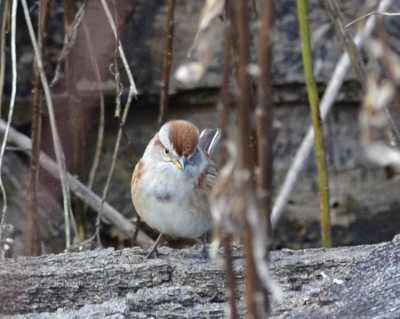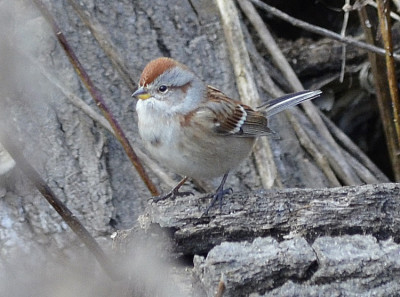Each fall, I look forward to the return of our neighbourhood flock of Dark Eyed Juncos. They are a bit shy and if I get too close to where they are eating sunflower seeds scattered on our back patio they flash their white outer tail feathers in victorious Vs as they fly away. This fall, however, I realized we have another bird that thinks southern Ontario is a lovely warm winter destination. These brown and white sparrows sport cheerful rusty caps and they have a noticeable bill. The top half is black and the bottom half is yellow.
In Search of Sparrows, American Tree Sparrows that Is
I saw a report from a local bird watcher that American Tree Sparrows were “back” in a nearby park. I wasn’t quite sure what that meant, so I looked up the name on AllAbout Birds, the Cornell University website. To my surprise, I found these sparrows are like juncos. They prefer to nest in northern Canada, way up in the tundra, and consider southern Ontario a warm and wonderful place to spend the winter.
I checked eBird for recent reports. Some had been seen at the Riverwood Conservancy in Mississauga. The reports also included White Throated, Song and Fox as well as American Tree Sparrows, so I thought I’d find something of interest.
After about 2 hours of wandering through the huge park in a bitter wind with occasional sprinkles of ice cold rain, I had found the Song and White Throated Sparrows but no Foxes or Trees. Just like when I first went looking for Indigo Buntings, I realized sheepishly that I didn’t know *where* I should be looking.
Don’t Look for American Tree Sparrows in the Tree Tops
Do American Tree Sparrows prefer to feed on seeds or insects in the tops of the trees like some of the Chickadees I kept meeting? Or are they interested in the seeds among the reeds and rushes along the Credit River? Maybe they prefer to feed in small shrubs? Or on the ground like the Juncos?
I had assumed they would prefer the tree tops given their name. Foolish naturalist! AllAboutBirds says that the name “Tree Sparrows” was given to the birds by early European settlers who thought it was similar to a tree-loving bird in Europe. The Cornell website suggested I try looking at ground level, especially “in weedy fields with hedgerows or shrubs, along forest edges, or near marshes.”
My second trip out to Riverwood was successful. I checked out a wild meadow of goldenrod, thistles and New England Asters. It was hard to get a look into the densely overgrown field but with the help of a few large sections of logs deliberately dumped by the parks staff, I was able to get a view down into the tulgy.
What Makes It Easy to Identify Tree Sparrows?
The first thing I noticed was the two toned beak. Right away that made me confident I wasn’t looking at another rusty-capped sparrow like a Chipping Sparrow. The bright yellow lower half of the bill is really noticeable.
I also noticed the plain grey chest. The Song Sparrows feeding in the same field have lots of streaks on their fronts. It was helpful there was such a noticeable difference between the two species, because the American Tree Sparrow did have a small but obvious dark dot in the centre of its chest. Song Sparrows often have a black spot too. The lack of stripes and streaks made it clear these were totally different birds.
What Was the Tree Sparrow Eating?
When I was watching, the American Tree Sparrow was hopping around on a very large decaying section of a tree trunk. So it wasn’t immediately clear what was for lunch. It could have been after insects in the wood or seeds from the goldenrod, asters, milkweed, Manitoba Maple and other plants nearby.
According to AllAboutBirds, Tree Sparrows are partial to both insects and seeds. Usually in the fall and winter they eat mostly seeds, including goldenrod seeds. In the spring and summer they eat more insects and some berries.
So I don’t really know what my sparrow was eating. Whatever it was, I hope it helped warm it up as it was only just above freezing.
Winter Brings Its Own Rewards
So winter does bring some compensations. I get to see Dark Eyed Juncos and American Tree Sparrows, Long Tailed Ducks and Bufflehead. In the spring, they’ll drift away to the north but the brightly coloured warblers and orioles will return to replace them. No matter what the season, there’s something wonderful out there to see.
Related Reading
For This Bird, Flying South for a Winter Warmup Means: Toronto?!
Join In
Have you had American Tree Sparrows visit your feeder? Do you look forward to their cheerful appearance each autumn? Please share your experiences with a comment.



These are great pictures! You’re reallly working hard.
Thanks! One of these days I’ll get a photo I really like, till then I just take lots and hope for the best.